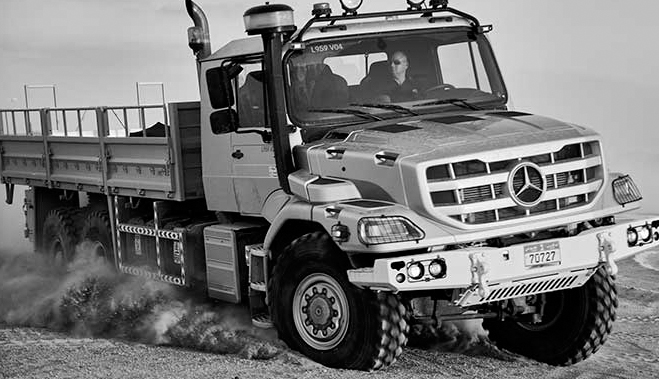Mercedes launches next generation heavy duty Zetros truck
The new Zetros has been completely re-worked all around: from a technical standpoint, the new Zetros remains available in Euro III and Euro V emission norms and comes equipped with a more powerful 12.8 liter engine, capable of delivering as much as 350 kW (476 hp) in Euro III and up to 375 kW (510 hp) in Euro V. All vehicles are equipped with a 16-speed manual gearbox with a striking 2400 Nm of torque at the highest engine output.
On the outside, the new model generation is distinctive in its striking, restyled radiator grille, which, thanks to optimized airflow guidance, ensures even more effective cooling. The new Zetros keeps its signature characteristics with a low silhouette and the cab behind the engine concept, in addition to an optional fording ability of up to 800 mm.
The new Zetros will be available as a specialist truck with extreme off-roading capabilities, a product of its permanent all-wheel drive system with 4×4 or 6×6 configuration. The product portfolio will expand to include a 6×4 configuration with start of production in September 2020. The portfolio will be complete in Q1/2021 with the introduction of the 4×2. All vehicles are available in three different wheelbases as well as different weight variants.
The cabin interior features numerous detail improvements, such as a re-designed instrument panel and an electronic parking brake. It keeps key characteristics of the predecessor, like the fully-fledged middle seat, as optional equipment.
The Mercedes-Benz Zetros is a heavy-duty truck, which has been developed for demanding transport tasks involving high payloads. That is why it is often used for delivering supplies to remote regions, as well as in energy exploration and in forestry operations. The new Zetros can be used all over the world across all extreme climates – from hot desert regions right up to the Arctic. Just as before, the new Zetros remains available in Euro III and Euro V variants for markets with poor fuel quality, and thus finds its principal markets in regions like the Middle East, Africa, and Latin America.


